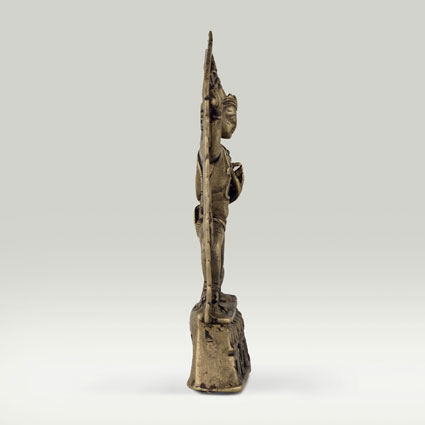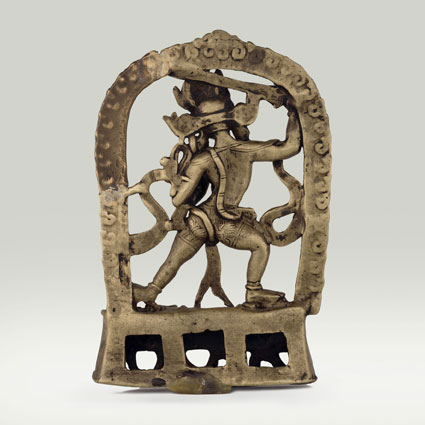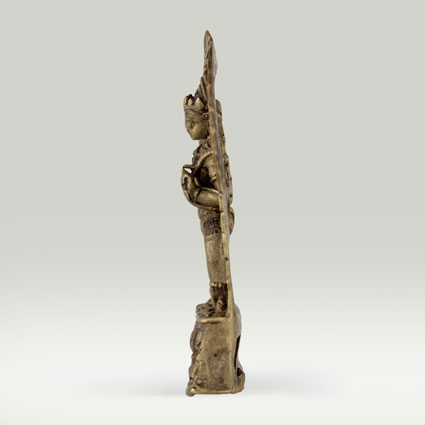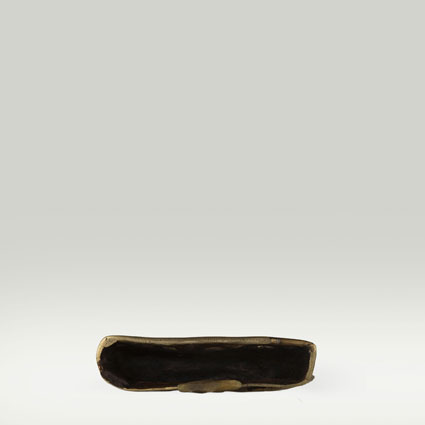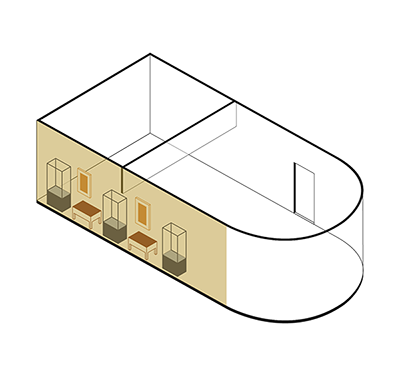ABS 050
Code: ABS 050
Country: Tibet
Style: Late Pala Style
Date: 1050 - 1150
Dimensions in cm WxHxD: 2 x 11.2 x 5.7
Materials: Brass
Cast in one piece, partly hollow.
The jewelled ornaments are inset with turquoise and coral.
The tiger skin and ornaments are decorated with engraved linear designs and clusters of dots.
The bottom of the open-worked pedestal is not sealed.
The repair of the aureole seems to be ancient.
The fearsom form of Acala (Tib. Mi g. yo ba) with three eye is standing on a single lotus pedestal mounted upon an open-worked stand. Acala tramples with the right foot on the defeated body of the elephant-headed Brahmanical god Ganesa (Tib. Tshogs bdag), and with the left foot an other Brahmanical deity, both prostrate on the lotus pedestal. Acala steps to the right with the right leg bent and the left straight (pratyalidha). In the raised right hand he brandishes a sword (khadga) as a symbol of "cutting throug ignorance"; with the left hand, displaying the gesture of exorcisme (karama-mudra) he holds a noose (pasa), an attribute of mainly wrathful deities. Acala is clad in a tiger skin (vyaghracarma)) tied below the belly. He is decorated with ornaments, namely a crown composed of two snakes (naga) in front of the prominent knot of hair with a small effigy of Akshobhya, a pair of circular earrings, two necklaces, and bracelets. the image is set against a open- worked aureole decorated with flames.
Basically, the stylistic features of this image follows the artistic tradition flourishing in the North-Eastern India during the later Pala period during the 11th and 12th centuries. However, there can be no doubt that this statue has been manufactured in Tibet. This is clearly demonstrated by the design of the open-worked stand which is destinctively Tibetan in style, and does not follow the Pala tradition. However, there is a possibility that this image was modelled by an Indian craftman working in Tibet. In this case the open-worked stand could...
Also known as Acalanatha, Aryacalanatha, Acala-vidya-raja and Candamaharosana. In Vajrayana Buddhism, Acala (alternatively, Achala or Acala) is the best known of the Five Wisdom Kings of the Womb Realm. Acala means "The Immovable One" in Sanskrit. Acala is also the name of the eighth of the ten stages of the path to buddhahood.
Acala is the destroyer of delusion and the protector of Buddhism. His immovability refers to his ability to remain unmoved by carnal temptations. Despite his fearsome appearance, his role is to aid all beings by showing them the teachings of the Buddha, leading them into self-control.
He is seen as a protector and aide in attaining goals. Temples dedicated to Acala perform a periodic fire ritual in devotion to him.
The buddha Akshobhya, whose name also means “the immovable one”, is sometimes merged with Acala. However, Acala is not a buddha, but one of the Five Wisdom Kings of the Womb Realm in Vajrayana as found in the Indo-Tibetan tradition, as well as the Japanese Shingon sect of Buddhism. As 'Fudo myo-o', Acala is considered one of the Thirteen Buddhas in Japan
Iconography
Acala is typically depicted with a sword for subduing demons in his right hand and a rope for catching and binding them in his left hand. He has a fearsome blue visage and is surrounded by flames, representing the purification of the mind. He is often depicted seated or standing on a rock to show his immovability. His hair commonly has seven knots and is draped on his left side, a servant hairstyle in Buddhist iconography. He is frequently depicted with two protruding fangs. One tooth points down, representing his compassion to the world, and one tooth points up, representing his passion for truth.
Béguin, Gilles, 2013. Art sacré du Tibet – Collection Alain Bordier, [catalogue of the exhibition held at the Fondation Pierre Bergé – Yves Saint Laurent; 14 mars au 21 juillet 2013]. Paris: Fondation Pierre Bergé – Yves Saint Laurent. Editions Findakli.
Chandra, Lokesh, 1991. Buddhist Iconography of Tibet (CBIT). New Delhi: International Academy of Indian Culture & Aditya Prakashan. nos. 13, 187, 202, 322, 682-687, 775, 934-935, 2377 (174), 2422 (219) - References to the iconography of Acala
Cornu, Philippe , 2001. Dictionnaire Encyclopédique du Bouddhisme. Seuil. Pp. 33-34
de Mallmann, Marie-Thérèse, 1963. “Notes d’iconographie tântrique: III. A propos du Fudô bleu [Acala]”, Arts Asiatiques. Tome IX, Fasc. 1–2. EFEO, Musée Guimet. Pp. 73-79, fig 1 - References to the iconography of Acala
de Mallmann, Marie-Thérèse, 1964. Étude iconographique sur Manjusri. Paris: École Française d’Extrème-Orient. Pp. 16, 30, 32, 70-71, 111-112, 128-32 - References to the iconography of Acala
de Mallmann, Marie-Thérèse, 1975. Introduction à l'iconographie du tântrisme bouddhique. Paris: Adrien Mainsonneuve (Jean Maisonneuve successeur (1970). Pp. 83-85 - References to the iconography of Acala
Frédéric, Louis, 1992. Les Dieux du Bouddhisme. Guide iconographique . Paris: Flammarion. p. 201 sq. - Sur l'iconographie d'Acala
Heller, Amy, 1999. Tibetan Art Tracing the Development of Spiritual Ideals and Art in Tibet 600-2000 A.D.. Jaca Books.
Huntington, John C.; Bangdel, Dina und Arvidsson, Björn (Traduction), 2010. Le Cercle de la Félicité. Art Méditatif Bhouddhique. «The cercle of Bliss. Buddhist meditational Art».. Genève: Duo Visual.
Rambach, Pierre, 1978. Le Bouddha secret du tantrisme japonais. Genève: Skira . Sur l'iconographie d'Acala
von Schroeder, Ulrich, 2001. Buddhist Sculptures in Tibet. Vol. One: India & Nepal; Vol. Two: Tibet & China. Hong Kong: Visual Dharma Publications, Ltd.. Pp. 1038-1039, 1112-1113; Pls. 259, 291 - Compare with other images of Acala


